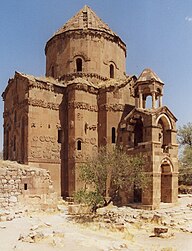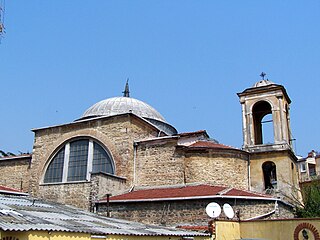
Vazgen I also Vazken I of Bucharest,, born Levon Garabed Baljian was the Catholicos of All Armenians between 1955 and 1994, for a total of 39 years, the 4th longest reign in the history of the Armenian Apostolic Church. The following three served for 39 years as Catholicos of All Armenians or Catholicos of the Great House of Cilicia:
- Peter I (1019–1058) — Պետրոս Ա Գետադարձ,
- Gregory II the Martyrophile (1066–1105) — Գրիգոր Բ. Վկայասէր and
- David IV (1590–1629), d. 1633 — Դավիթ Դ Վաղարշապատցի.

The Armenian Patriarch of Constantinople, also known as Armenian Patriarch of Istanbul, is today head of the Armenian Patriarchate of Constantinople, one of the smallest Patriarchates of the Oriental Orthodox Churches but one that has exerted a very significant political role and today still exercises a spiritual authority.

The Balyan family was a prominent Armenian family in the Ottoman Empire consisting of court architects in the service of Ottoman sultans and other members of the Ottoman dynasty during the 18th and 19th centuries. For five generations, they designed and constructed numerous major buildings in the Ottoman Empire, including palaces, mansions, konaks, kiosks, yalis, mosques, churches, and various public buildings, mostly in Constantinople.
Archbishop Mesrob II Mutafyan, or Mutafian, also known as Mesrop Mutafyan in Eastern Armenian transliteration, was the 84th Armenian Patriarch of Constantinople. The Armenian Patriarchate of Constantinople is one of the four Sees of Armenian Apostolic Church and has an autocephalous status, accepting, on the other hand, spiritual supremacy of the Catholicos of Armenia and of all Armenians in Holy Echmiadzin.

Catholicos Karapet II Oolnetzi was the Catholicos of the Armenian Apostolic Church between 1726 and 1729.

The 20 Hunchakian gallows is the common name for the group of Hunchakian activists who were hanged in the Sultan Beyazıt Square of Constantinople on June 15, 1915 during the Armenian genocide.
Like most communities of the Armenian Diaspora, the Armenian-Cypriot community is predominantly Armenian Apostolic. Some 5% belong either to the Armenian Evangelical Church, the Armenian Catholic Church, the Latin Church, the Greek Orthodox Church, the Anglican Church, the Plymouth Brethren Church, the Seventh-day Adventist Church or they are Jehovah's Witnesses; of this 5%, historically the most significant groups have been Armenian Evangelicals, who in the 1940s and 1950s comprised about 10% of the Armenian-Cypriot community, and Armenian-Catholics, who have been on the island since the time of the Crusades.
Despite its small size, the Armenian-Cypriot community has plenty of monuments to show:

Catholicosate of Aghtamar was an independent see of the Armenian Apostolic Church that existed for almost eight centuries, from 1113 to 1895 and was based in the Cathedral of the Holy Cross on the Aghtamar Island near Van, in present-day Turkey.
Catholicos Abraham II Khoshabetzi was the Catholicos of the Armenian Apostolic Church between 1730 and 1734.
Martiros is an Armenian given name meaning martyr.

The Saint Gregory the Illuminator Church of Galata is the oldest extant Armenian Apostolic church in Istanbul. It was built in the late 14th century, in the Genoan period, shortly before the fall of Constantinople to the Ottomans. Located in Galata (Karaköy), it is the city's only church built in the traditional style of the Armenian church architecture—namely with a dome with a conical roof.
Vachutian dynasty was an Armenian noble feudal family headed by a line of princes with the title "Prince of Princes", that ruled as a suzerainty in part of Medieval Armenia from around 1206 AD to 1350 AD in the Ayraradian area and Aragatsotn Aparan.

Surp Krikor Lusavoriç Armenian Church is an Armenian Apostolic church dedicated to Saint Gregory the Illuminator in Kuzguncuk, Üsküdar, Istanbul, Turkey. It was rebuilt in 1861.